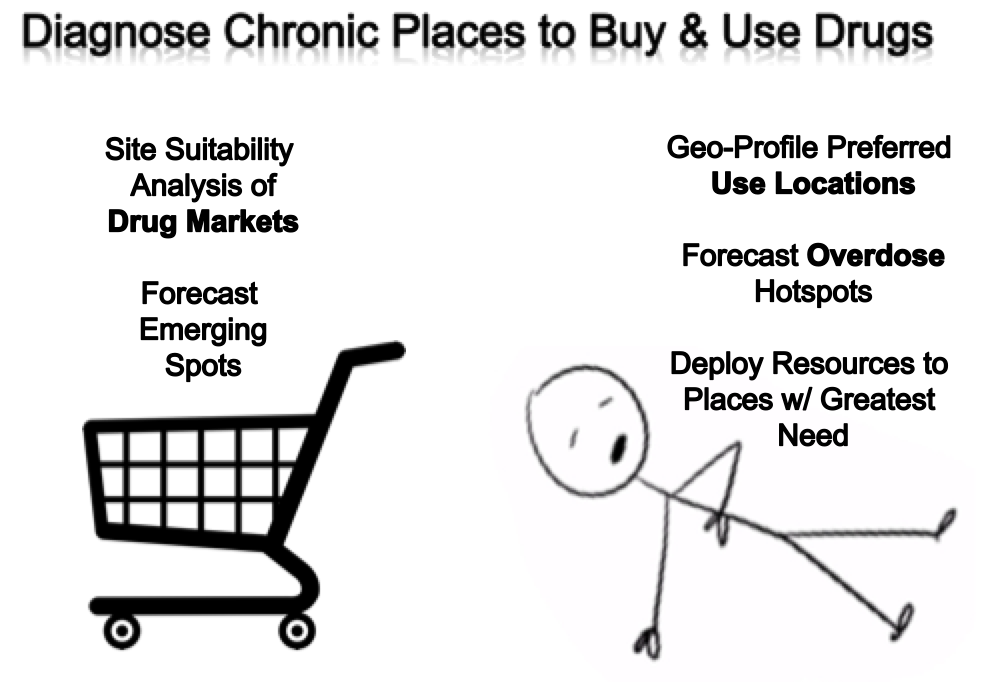|
Risk Terrain Modeling (RTM) analyzes illicit drug trafficking, sales and use. RTM diagnoses seller and buyer preferences for drug markets and forecasts alternative spots or emerging settings for displacement or expansion of this behavior. RTM has been used in the United States to profile how the physical landscape affects drug dealing (of many kinds of drugs). Open-air dealing, in particular, is a complex endeavor between buyers and sellers who are frequently strangers or only loosely acquainted. Yet they must find a way to balance a competing set of demands: access and security. In the Chicago study, drug dealers and buyers took advantage of several features of the environment to establish ideal opportunities this transaction. Different types of drugs had different ideal settings, or markets, based on specific environmental qualities. These findings inform place-based policies and intervention strategies (including policing) aimed at disrupting drug markets. RTM has also been used to analyze and intervene at drug use locations, to forecast overdose 'hot spots', and to preemptively deploy resources to these places that are in the greatest need of intervention. Some public health oriented interventions have been to strategically deploy Narcan to city officials or business owners working in certain areas -- to enable overdose treatments quickly, and save lives; to place more sharps containers in public spaces -- to minimize littering of used syringes and accidental exposures to residents, visitors and public employees; to locate 9-1-1 call boxes (e.g., emergency cell phones) -- to enable reporting of overdoses or other emergencies; and to optimize advertising and recruitment campaigns for drug treatment and supportive services. Students at the University of Pennsylvania produced a spatial risk model of opioid overdose events for the City of Providence, Rhode Island by examining overdose locations in relation to environmental risk factors, community protective resources, and neighborhood characteristics to offer an assessment of areas in the city where local stakeholders can strategically allocate resources to achieve the greatest impact. The Providence Safe Stations program or the Providence Healthy Communities Office can use forecasted high-risk places for overdose as a site suitability analysis or to improve outreach and communication efforts. ...because drug dealers seek strategic locations and conditions were profit margins are maximized, the risk terrains depicting these places serve as excellent place-based forecasts. In Bogota, policies and hotspot policing practices intended to suppress illicit drug markets have resulted in sale locations becoming more dispersed. This has made monitoring and intervention even more difficult for local authorities. But new efforts at monitoring the markets of three illicit substances (cocaine, marijuana and basuco) provides valuable insights for disrupting emerging trends. Escudero and Ramírez found *drug prices* to be closely tied to certain environmental variables. And, because drug dealers seek strategic locations and conditions were profit margins are maximized, the risk terrains depicting these places serve as excellent place-based forecasts. RTM also offers actionable intel for effectively disrupting the situational contexts of these settings.
The Ideas for Peace Foundation used RTM to study microtrafficking of drugs in 5 Colombian cities (PDF reports from the Colombian Ministry of Justice): Bogota, Pasto, Medellin, Cali and Barranquilla Environmental features can influence drug sales and use behaviors, and aggravate risks of chronic drug markets at particular places. RTM can help to diagnose these environmental vulnerabilities and identify places that are most in need of resources and risk reduction strategies. Comments are closed.
|
|
|
The official website of Risk Terrain Modeling (RTM) research and resources, based out of Rutgers, The State University of New Jersey.
|


 RSS Feed
RSS Feed